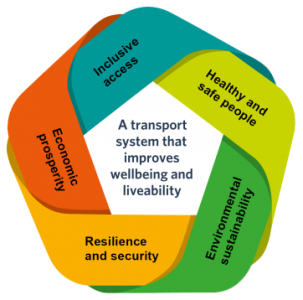
As a foundation, Arataki uses the Transport outcomes framework from Te Manatū Waka Ministry of Transport. This framework sets long-term outcomes for the transport sector to work towards. These include:
- inclusive access
- healthy and safe people
- environmental sustainability
- economic prosperity
- resilience and security.
Transport outcomes framework – Ministry of Transport(external link)
The Strategic context of Arataki has full guidance on the challenges and opportunities, as well as information about what the land transport system will look like in 30 years, plus key drivers for future change.
Arataki September 2023 v1.1 updates the March 2023 release of the Strategic context to reflect the severe weather events of 2023 and make minor corrections.
Arataki strategic context [PDF, 5.4 MB]
Inclusive access
The transport system should be accessible by all people in Aotearoa New Zealand, regardless of disability, income, age, gender, sexuality, and ethnicity.
To address this outcome, we are:
- continuing to partner with other agencies to deliver good urban form
- continuing to encourage the use of public transport and active modes
- supporting access for a range of groups
- encouraging licensing and safer driving
- providing access to safer cleaner vehicles.
We still need to work on:
- developing clear focus and targets
- better integrating land-use and transport planning to improve urban form and the access to key services
- shifting from reliance on single-occupancy vehicles to more sustainable transport solutions, particularly in our cities.
Healthy and safe people
A healthy and safe system protects people from transport-related injuries and harmful pollution and makes physically active travel an attractive option.
To address this outcome, we are improving:
- road safety
- rail safety
- safety for Māori
- safety for in urban and rural areas
- public health.
We still need to work on:
- developing a whole-of-system approach to improve public health in transport services, with an increased focus on reducing air pollution
- providing cost-effective incentives that reduce private vehicle use to encourage public transport or active modes
- developing a work programme for rail safety beyond the three-year timeframe of the current Rail Network Investment Programme
- improving our understanding of safety outcomes and programmes for Māori that reduce safety and public health risks
- developing a strategic direction beyond the current strategy to reach the Road to Zero vision of reducing transport-related deaths and serious injuries.
Environmental sustainability
The transport system must transition to net-zero carbon emissions. It will maintain or improve biodiversity, water quality, and air quality.
To address this outcome, we are:
- reducing light vehicle kilometres travelled (VKT)
- reducing freight transport carbon
- rapidly adopting low-emissions vehicles
- reducing impact on biodiversity (including impact on water quality)
- improving resource efficiency and waste.
We still need to work on:
- reducing greenhouse gas emissions
- improving biodiversity (including water quality)
- improving resource efficiency and waste
- reducing embodied carbon.
Economic prosperity
The transport system supports economic activity through:
- local, regional, and international connections
- efficient movement of people and products.
To address this outcome, we are continuing to:
- move more freight by rail and coastal shipping
- improve freight productivity
- support network resilience
- contribute to good planning and urban form
- improve safe access to jobs.
We still need to work on:
- the New Zealand Freight and Supply Chain Strategy (Waka Kotahi support role)
- reduction of freight transport carbon (Waka Kotahi support role)
- densification (concentration) in urban areas
- data, technology, and digital
- sector-wide collaboration.
Resilience and security
A resilient and secure transport system:
- minimises and manages the risks from natural and human-made hazards
- anticipates and adapts to emerging threats, and
- recovers effectively from disruptive events.
To address this outcome, we are:
- improving resilience
- adapting to climate change
- improving security.
We still need to work on:
- improving resilience from natural hazards
- adapting to climate change and delivering on actions
- improving security.
![]()